|
|
|
Sort Order |
|
|
|
Items / Page
|
|
|
|
|
|
|
| Srl | Item |
| 1 |
ID:
177787
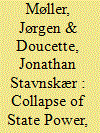

|
|
|
|
|
| Summary/Abstract |
Several generations of scholarship have identified the medieval development of urban self-government as crucial for European patterns of state formation. However, extant theories, emphasizing structural factors such as initial endowments and warfare, do little to explain the initial emergence of institutions of urban self-government before CE 1200 or why similar institutions did not emerge outside of Europe. We argue that a large-scale collapse of public authority in the ninth and tenth centuries allowed a bottom-up reform movement in West Francia (the Cluniac movement), directed by clergy but with popular backing, to push for ecclesiastical autonomy and asceticism in the eleventh and twelfth centuries. These social realignments, facilitated by new norms about ecclesiastical office holding, stimulated the urban associationalism that led to the initial emergence of autonomous town councils. Using a panel data set of 643 towns in the period between 800 and 1800, we show that medieval towns were substantially more likely to establish autonomous town councils in the period between 1000 and 1200 if they were situated in the vicinity of Cluniac monasteries. These findings are corroborated by regressions that use distance from Cluny—the movement's place of origin—to instrument for proximity to Cluniac monasteries.
|
|
|
|
|
|
|
|
|
|
|
|
|
|
|
|
| 2 |
ID:
140329
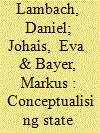

|
|
|
|
|
| Summary/Abstract |
This paper proposes a theoretically grounded and methodologically rigorous conceptualisation of state collapse. It seeks to overcome several key deficits of research into fragile, failed and collapsed states, which is often criticised as normatively problematic and methodologically deficient. We argue that this is a worthwhile topic to study but that scholarly inquiry needs to become more systematic and focus on extreme cases of state collapse. Following a Weberian institutionalist tradition, we disaggregate statehood into three dimensions of state capacity: making and enforcing binding rules, monopolising the means of violence and collecting taxes. We then propose a set of indicators as well as a mode of aggregation based on necessary and sufficient conditions. Our framework identifies 17 cases of state collapse in the postcolonial era.
|
|
|
|
|
|
|
|
|
|
|
|
|
|
|
|
| 3 |
ID:
134091
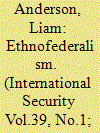

|
|
|
|
|
| Publication |
2014.
|
| Summary/Abstract |
Scholars are divided on the merits of ethnofederalism as an institutional approach to the management of ethnically divided societies. For some, ethnofederalism is a potentially workable compromise between the demands for independence of territorially concentrated ethnic groups and the desire of a common state to preserve its territorial integrity; for critics, it is a short-cut to secession and ultimate state collapse. The argument of critics is theoretically plausible, but an examination of the universe of post-1945 states with ethnofederal arrangements, both failures and successes, shows that ethnofederalism has succeeded more often than it has failed. Within this universe of cases, moreover, ethnofederalism has demonstrably outperformed institutional alternatives, and where ethnofederal systems have failed, they have failed where no institutional alternatives could plausibly have succeeded. The increasing enthusiasm among policymakers and practitioners for prescribing federal solutions to ethnic problems is both understandable and defensible in light of these findings.
|
|
|
|
|
|
|
|
|
|
|
|
|
|
|
|
| 4 |
ID:
163699
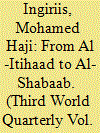

|
|
|
|
|
| Summary/Abstract |
External intervention has frustrated and continues to frustrate peace and stability in the Horn of Africa and Somalia, adding various adverse layers to an already complicated and complex conflict. The level of forceful military engagement intended for regional domination has profoundly affected negatively the efforts of peacebuilding and statebuilding in Somalia. This article examines how the earlier Ethiopian policies towards Somalia has reshaped the (post)-Cold War politics of the Horn. In doing so, it traces the roots of the Ethiopian intervention in Somalia vis-à-vis new non-state armed groups to chart the changing political dynamics of the conflict in Somalia. By using historical approach, the article argues that Ethiopia’s agenda is central to understanding why the ‘War on Terror’ has strengthened and subsequently midwifed armed militant movements (e.g. new insurgency groups) in Somalia, starting from Al-Itihaad to today’s Al-Shabaab. In focusing upon various regional actors and groups, the article moves from the emphasis of internal systems to external power structures, considering the wider historical and political factors in the region that must be closely examined if the regional and local conflicts are to be deeply understood. While it is a context-specific study, the article aims to contribute fresh perspectives and insights to ongoing discussions on the consequences of the Ethiopian intervention in Somalia.
|
|
|
|
|
|
|
|
|
|
|
|
|
|
|
|
| 5 |
ID:
172158
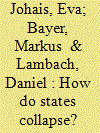

|
|
|
|
|
| Summary/Abstract |
State collapse is a highly consequential event. But we know very little about the reasons why and how states lose their capacities of violence control, rule-making and taxation. In order to explore the underlying causal mechanisms, we use a nested analysis combining Qualitative Comparative Analysis and comparative process-tracing. While the mobilisation of armed opposition groups is a necessary condition for state collapse, it only works in concurrence with other conditions, namely political transitions, repression, factionalism, intra-elite rivalry and external interventions. Thus, the article presents a causal model that shows the alternative pathways leading to state collapse.
|
|
|
|
|
|
|
|
|
|
|
|
|
|
|
|
| 6 |
ID:
183222


|
|
|
|
|
| Summary/Abstract |
At the height of the Syrian civil war, many observers argued that the Syrian state was collapsing, fragmenting, or dissolving. Yet, it never actually vanished. Revisiting the rising challenges to the Syrian state since 2011 – from internal collapse through external fragmentation to its looming dissolution by the ‘Islamic State’ – provides a rare opportunity to investigate the re-enactment of both statehood and international order in crisis. Indeed, what distinguishes the challenges posed to Syria, and Iraq, from others in the region and beyond is that their potential dissolution was regarded as a threat not merely to a – despised – dictatorial regime, or a particular state, but to the state-based international order itself. Regimes fall and states ‘collapse’ internally or are replaced by new states, but the international order is fundamentally questioned only where the territorially delineated state form is contested by an alternative. The article argues that the Syrian state survived not simply due to its legal sovereignty or foreign regime support, but also because states that backed the rebellion, fearing the vanishing of the Syrian nation-state in a transnational jihadist ‘caliphate’, came to prefer its persistence under Assad. The re-enactment of states and of the international order are thus ultimately linked.
|
|
|
|
|
|
|
|
|
|
|
|
|
|
|
|
| 7 |
ID:
172571


|
|
|
|
|
| Summary/Abstract |
Strikes conducted by the US using armed unmanned aerial vehicles (UAVs) against the terrorist group al-Shabaab have received widespread attention documenting the number of strikes, the reactions of the local Somalis, and the disparity between AFRICOM and local reporting. Using interview data from individuals in Mogadishu, Nairobi and elsewhere in the region, this article provides a counterpoint to previous studies by measuring the Federal Government of Somalia’s (FGS) reliance on the US drone campaign in Somalia in order to maintain its tenuous hold on power. It measures the extent to which the drone campaigns of external parties are able to insulate weak host governments from the threat of an internal foe. It finds that US drone strikes offer the occasional but only reliable check on al-Shabaab thereby allowing the FGS to continue functioning in Mogadishu. Yet strikes should not be construed as a sign of overt US support for the FGS. Rather, the US government, deeply suspicious of a highly corrupt and incapable FGS, continues to prosecute drone strikes against al-Shabaab because Washington considers the group poses a national security threat to the US.
|
|
|
|
|
|
|
|
|
|
|
|
|
|
|
|
|
|
|
|
|